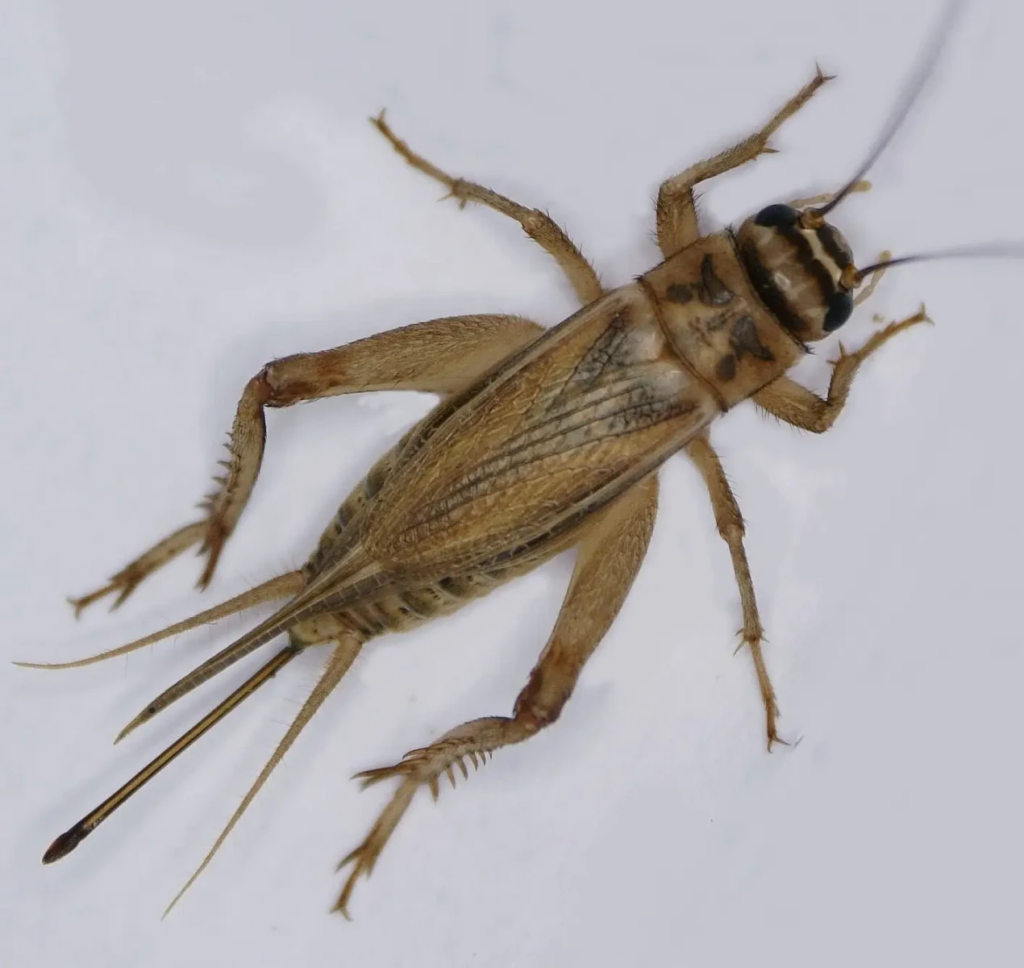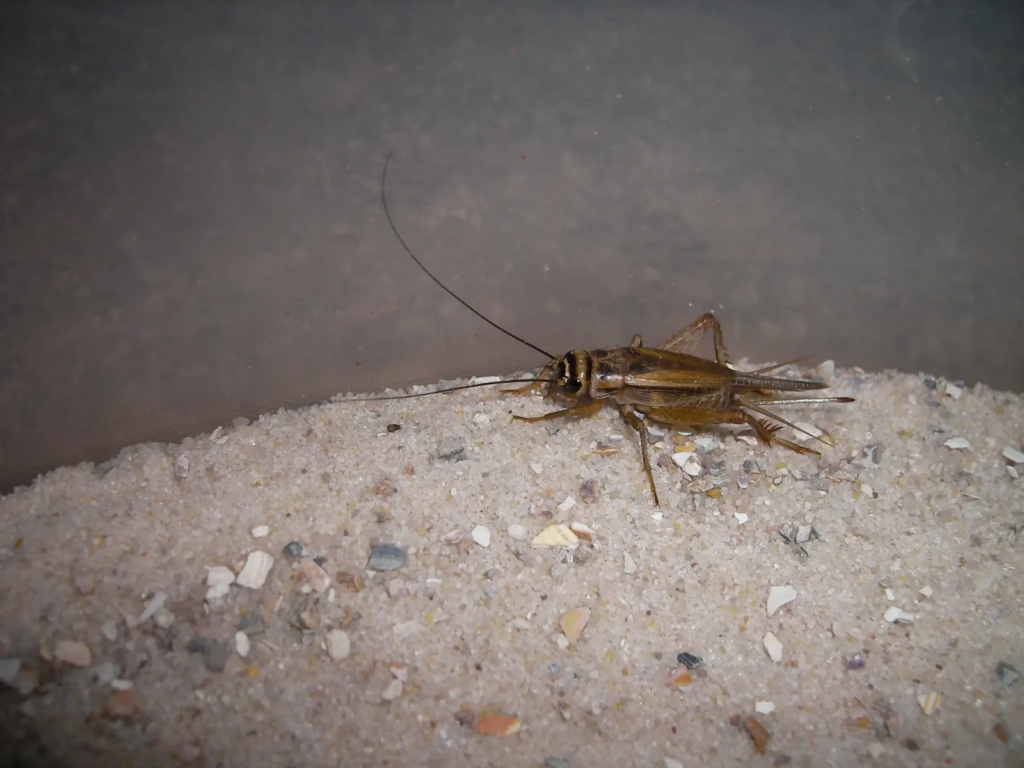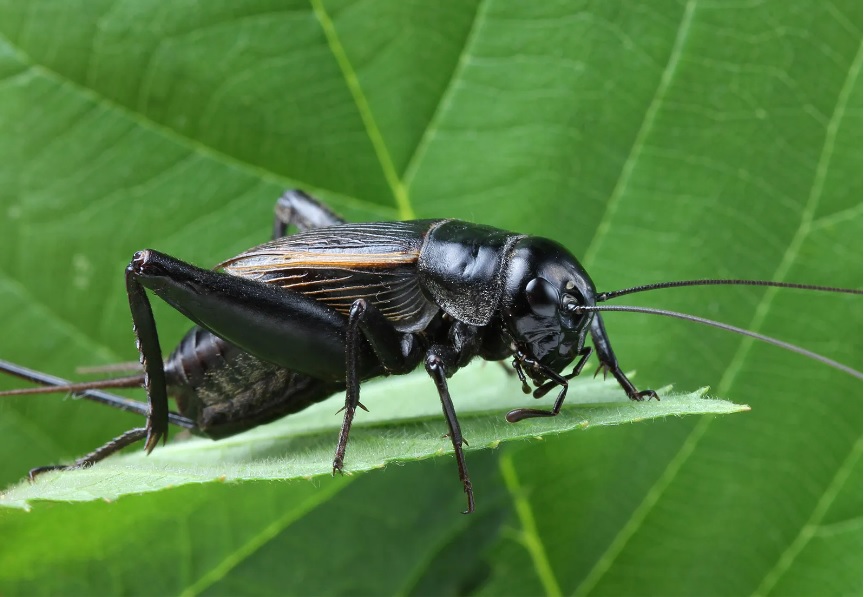Crickets are often seen as harmless insects, but their impact depends on context. They don’t bite or sting. But, their behavior can cause issues. The question “are crickets harmless” gains complexity when considering their actions in large groups.
Studies show crickets rarely pose physical harm. Yet, their chirping and swarming can disrupt homes. In big numbers, they may chew fabrics or damage plants, creating stress for homeowners. This duality shapes how we view their role in ecosystems versus human spaces.
Key Takeaways
- Crickets lack biting mouthparts, reducing direct harm.
- Chirping sounds can cause noise-related discomfort indoors.
- Large populations may damage fabrics or garden plants.
- Some people experience stress from their persistent presence.
- Management strategies address both benefits and potential problems.
Even though there is no proof that they hurt people’s health, the fact that their numbers are growing can be frustrating. Crickets like to chew on fabrics, leftover food, plants, paper, and other things. We know from years of experience getting rid of crickets that most people think these bugs are harmless. However, you may be surprised by how much trouble crickets may create.
Understanding Crickets: Misconceptions and Realities
Many myths about crickets are not true. People often think they bring bad luck or are pests. But, cricket facts show they play a key role in nature and for us.

Common Myths
One myth says crickets predict disasters. But, their chirping is for mating and to show temperature. They are not omens.
Another myth says they are big pests at home. While some crickets, like field crickets, can damage things, most don’t. Cricket farming helps control their impact.
Scientific Facts
Studies show crickets help with nutrients and are a good protein source. Cricket farming uses species like house crickets in safe places. This way, they don’t escape.
Knowing what crickets eat helps farmers create better homes for them. This approach is better than trying to get rid of them. It’s about understanding and managing them, not just getting rid of them.
The Role of Cricket Behavior and Habitat in Their Perceived Harmfulness
Cricket behavior, like seeking warmth and shelter, brings them inside when it’s cold. Their love for damp places often gets them into trouble with humans. Their chirping, though harmless, can still bother people.
To stop them, we need to change their environment. Sealing holes and keeping places dry makes their homes less appealing. Knowing how they behave helps us control them without hurting the environment.
Cricket protein is becoming more popular in green diets. But, dealing with them at home can still be tough. By understanding their habits and homes, we can live with them better. This way, we respect their place in nature while keeping our homes peaceful.

Cricket Anatomy and Lifespan: Key Insights
Cricket anatomy and their cricket lifespan are key for managing them well. They are important for pest control and farming edible insects. Knowing their biology helps us understand their behavior and weaknesses.
Understanding Cricket Diet
Cricket diets vary by species. They eat plants, fungi, and sometimes other insects. This flexibility helps them live in many places.
Raising crickets as edible insects means giving them natural food. But, they can become pests if food runs out. So, we need to manage them carefully.
Growth Stages
Cricket life stages are egg, nymph, and adult. Their cricket lifespan is 6–12 months. Nymphs grow in 2–3 months.
Eggs hatch in warm soil. This is why early control is important. Farmers use this to get more protein. Pest control stops eggs to control numbers.
Sustainable Protein Source: Benefits of Cricket Farming
Crickets, once seen as pests, are now key in a big change in farming. They are a green protein source, better than traditional livestock. They need much less water and land than cows or pigs.
Studies show that farming crickets is up to 90% better for the environment than raising cattle. This is because they produce fewer greenhouse gases.
Modern farms use special setups to make cricket farming more efficient. Unlike old ways, cricket farming turns feed into protein with little waste. Their protein is as good as beef, making them a healthy choice.
Companies like Chapul and Exo make snacks from crickets. These snacks are popular with people who care about the planet and their health.
Starting small, cricket farms can help local economies grow. They create jobs in rural areas. As demand increases, farms work to keep their impact small while producing quality cricket protein.
Cricket farming is a big step towards a greener future. It helps meet the world’s protein needs in a way that’s good for the planet. As more people learn about it, cricket farming is changing how we produce food.

Edible Insects: The Rise of Cricket Protein in Nutrition
More people are interested in eating insects as a sustainable protein source. Crickets, once seen as pests, are now a key player in food innovation. The United Nations says they could meet dietary needs and help the environment.
Nutritional Value
Crickets have 65% protein by weight, almost as much as beef. They are full of iron, zinc, and B12. This makes them a complete protein.
Studies show they help repair muscles and give energy. They need less water and land to farm than traditional meats.
Health Benefits
Eating insects is good for the planet and doesn’t lack in nutrition. Farming crickets for food uses less resources than raising livestock. This way, pests are controlled and turned into safe food.
They have omega-3s like fish, which is good for the heart. As farming crickets gets better, they help solve the problem of pests and provide food.
Entomophagy: A Look into Insect Farming Practices
Insect farming is key to balancing nature and human food needs. Modern farms use clean, controlled spaces to raise insects like crickets. They focus on keeping things clean and green.
These farms produce food rich in protein. They also help control pests. By managing where and how insects live, farms keep them from harming nature.
Places like Tiny Farms and Aspire Food Group use special methods. They control temperature and diet to keep crickets healthy. This way, they avoid problems with wild insects.
These farms work with pest control. They keep insects in safe places, reducing the need for harmful chemicals. This approach sees insects as a solution, not a problem.
Learning about insect farming helps communities see crickets in a new light. Training teaches how to handle and breed insects safely. As it grows, insect farming supports both food and the environment, changing how we fight pests.

Cricket Recipes and Culinary Innovations
Cricket recipes are changing how we see sustainable eating. Chefs and food lovers make new dishes with crickets. These dishes are full of protein and show off eco-friendly cooking.
Innovative Recipes
There are many creative cricket recipes. You can make energy bars, taco toppings, and even chocolate treats. Roasted crickets add crunch to salads, and powdered crickets mix well into smoothies.
Online guides and stores help you make these dishes. They show that crickets are both healthy and versatile.
Cooking Tips
To bring out their nutty taste, roast crickets at 375°F for 10–15 minutes. Add spices like cayenne or sesame oil for extra flavor. Keep processed crickets in airtight containers to stay fresh for weeks.
Start with small amounts in dishes you already like, like pasta sauces or trail mixes. This makes it easier to get used to.
But, we must be careful with cricket populations at home. We need to manage them well. This way, crickets can be a tasty addition to our meals, not a pest.
Treating Crickets: Care, Breeding, and Proper Handling
Managing crickets starts with good care and treatment. It’s important to know how to handle them safely. This way, we can enjoy the benefits of eating crickets without harm.
Effective Treatment Methods
Seal cracks and gaps in your home to keep crickets out. Use sticky traps in busy spots to catch them gently. For big problems, call a pest control pro.
Stop crickets from breeding by fixing their homes. Clean often and dry out places they like. This makes their homes less appealing.
Safe Handling Practices
Always wear gloves when touching crickets to avoid allergies or bites. Throw away dead insects to stop bad smells and pests. If you breed crickets for food, keep things clean and safe.
Dispose of crickets properly to stay healthy. This makes sure they’re safe to eat.
Cricket Care: Best Practices for Breeding and Habitat Management
Keeping crickets happy means taking care of their home. Crickets might seem harmless, but ignoring their needs can cause problems. Experts say to keep things dry and seal up any cracks to stop them from multiplying.
Managing their habitat is key. Cut back on plants near your house and make sure outdoor lights don’t attract bugs. Dry air and well-ventilated places for food also help keep them away. These steps help stop crickets before they become a big issue.
Looking after crickets long-term means checking for moisture and pests often. Even if crickets look harmless, they can be a nuisance if not managed. By taking care of these issues early, you can live peacefully with them. This approach helps avoid the need for quick fixes later on.

Crickets: Behavior, Diet, and Natural Habitat
Learning about cricket behavior and where they live is key. Their chirping and eating habits tell us important cricket facts. These facts help us find ways to stop and control them.
Understanding Chirping Patterns
Cricket chirping is how they talk to each other. Males make sounds to find mates or warn others. The temperature and how wet it is change how fast they chirp.
Farmers listen to these sounds to know when to act. This helps them plan the best times to stop the crickets.
Nutritional Observations
Crickets love to eat plants and rotting stuff. What they eat helps them choose where to live. They like places that are moist and have food.
By watching what they eat, we can find where they are most likely to be. This helps us target our efforts to stop them.
Using what we know about their behavior and where they live helps us fight them better. We can stop them early without hurting the environment. This way, we keep pests under control while being kind to nature.
The Impact of Cricket Chirping: Communication and Environment
Cricket chirping is key for these insects to talk to each other. Males make sounds to find mates or warn others. But, too much noise can mess up sleep and cause stress.
Managing their homes is important for cricket care. Too many crickets make more noise. Changing their space, temperature, and food can help. Also, keeping their numbers in check helps keep the noise down.
To solve chirping problems, we need to know why it happens. Using barriers or smart habitat placement helps. Regular checks keep cricket numbers in balance. This way, we can live peacefully with them.
Cricket Breeding: Techniques and Sustainable Practices
Cricket breeding mixes science with care for the planet. Farmers and scientists pick special ways to breed crickets like Gryllus bimaculatus. They aim to increase their numbers without harming the environment.
They keep crickets in controlled places. This makes sure they grow well, cuts down on waste, and keeps them healthy.
Breeding Methods
Choosing the right crickets starts with knowing what they need. For crickets like Acheta domesticus, it’s important to control the temperature and humidity. They do best in warm, moist places.
Putting males and females together at the right time helps them have more babies. Some farms use machines to feed them the same food all the time. This helps them lay eggs without getting too crowded.
Lifecycle Management
Watching how crickets grow helps farmers keep them in check. They track how eggs develop and how young crickets grow. This helps them plan when to breed.
For people at home, knowing this helps stop unwanted crickets. By breeding in sync with nature, farmers lower the chance of crickets getting loose and spreading.

Treating Insect Infestations: When Crickets Become a Concern
Cricket populations can be good for the environment and a food source. But, too many can cause trouble. It’s important to act fast to protect our homes and things we own.
Spotting problems early and taking steps early on helps a lot. This way, we can stop big issues before they start.
Identifying Infestation Signs
Big problems show up when crickets chirp a lot at night. They can also damage fabrics or paper. Seeing crickets inside means there’s a big group.
Look for droppings or nests in basements, kitchens, and storage. Waiting too long can cause more damage to clothes, food, or buildings.
Preventative Measures
To stop crickets, fix your home’s cracks and screens. Also, clean up outdoor messes where crickets like to hang out. Trim bushes and dry out soil to keep them away.
Keep food sealed and clean spills right away. For really bad cases, call a pest control service. They can use special sprays or baits.
Check crawl spaces and attics often. This helps catch problems early. By doing these things, we can keep our homes safe and still enjoy crickets in nature.

Conclusion
Crickets play a big role in our world. They eat plants and organic stuff, which is good and bad. When farmed right, they offer healthy protein. But, in homes, they can cause trouble if not kept in check.
It’s key to know how to handle them. Keeping their homes clean and watching what they eat helps. This way, they can be good for the planet. But, knowing how they act and eat helps stop them from being pests.
The easiest approach to protect you and your home from crickets and minimize their population is to contact us, Vinx Pest Control. Let us inspect it and treat your problem. Don’t stand a chance to hear crickets at midnight. Sleep better, and rest assured, knowing your family is safe.
FAQ
Are crickets harmful insects?
Crickets are mostly harmless. But, too many can be annoying. They might damage property or cause stress with their chirping.
What are some common myths about crickets?
Many think crickets are dangerous. But, they’re mostly a nuisance. Their loud chirping and fabric damage are the main issues.
How do environmental factors contribute to cricket infestations?
Crickets like warm, damp places. Basements are perfect for them. This is why they often infest these areas.
What does the cricket life cycle look like?
Crickets go through egg, nymph, and adult stages. Knowing this helps manage pests and supports cricket farming.
What are the benefits of cricket farming?
Cricket farming is good for the economy and environment. It offers a sustainable protein source and helps control infestations.
What nutritional benefits do crickets offer?
Crickets are full of protein, vitamins, and minerals. They’re a sustainable food source, as the UN suggests.
What is entomophagy?
Entomophagy is eating insects. It’s becoming popular. It helps manage pests and provides a nutritious food option.
How can I use crickets in my cooking?
You can use crickets in many dishes. They can be ground into flour or used as a topping. They add crunch and nutrition.
What are effective methods for treating cricket infestations?
To treat infestations, seal entry points and use non-toxic traps. Professional help is also an option. This keeps treatments safe and effective.
How can I manage the cricket population in my home?
Keep your home dry and seal cracks. Trimming vegetation helps too. These steps reduce their attraction and chirping.
What do crickets eat?
Crickets eat organic matter like plants and decomposing stuff. If they find favorable outdoor conditions, they might come inside.
What is the significance of cricket chirping?
Chirping is how crickets communicate. They use it to attract mates and mark territory. But, too much can be a nuisance.
How can I identify signs of a cricket infestation?
Look for more chirping, visible crickets, and damage. Catching it early helps manage and prevent infestations.
What sustainable practices can be used for cricket breeding?
For sustainable breeding, control environments and manage life cycles. Monitor populations to avoid overcrowding and infestations.



